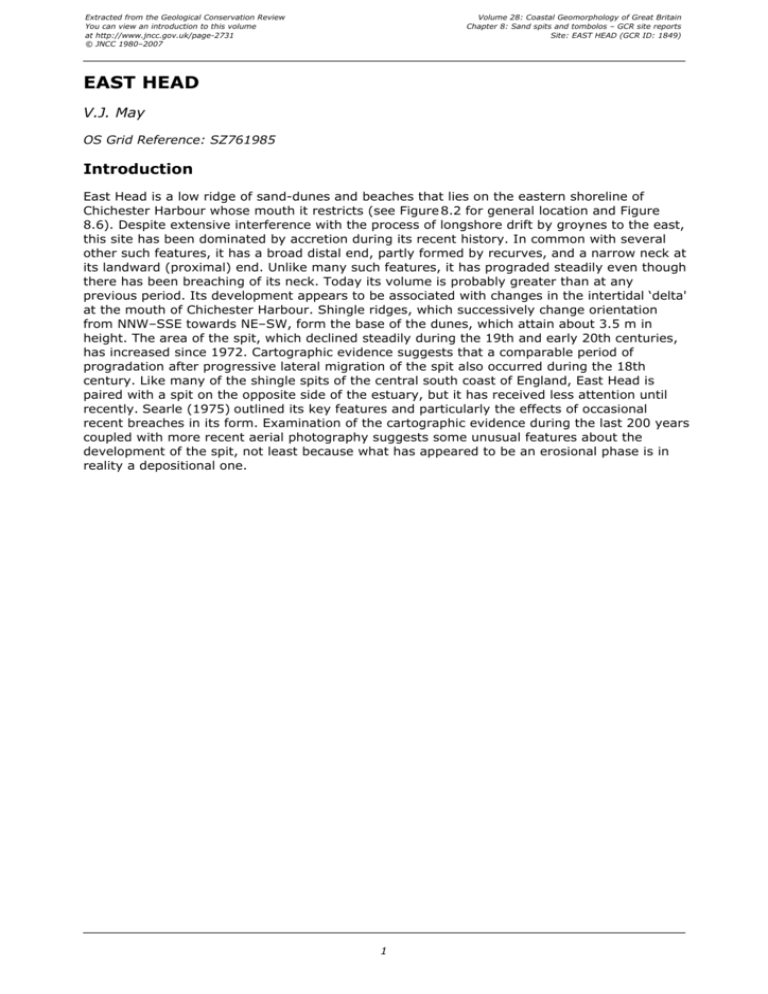EAST HEAD
advertisement

Extracted from the Geological Conservation Review You can view an introduction to this volume at http://www.jncc.gov.uk/page-2731 © JNCC 1980–2007 Volume 28: Coastal Geomorphology of Great Britain Chapter 8: Sand spits and tombolos – GCR site reports Site: EAST HEAD (GCR ID: 1849) EAST HEAD V.J. May OS Grid Reference: SZ761985 Introduction East Head is a low ridge of sand-dunes and beaches that lies on the eastern shoreline of Chichester Harbour whose mouth it restricts (see Figure 8.2 for general location and Figure 8.6). Despite extensive interference with the process of longshore drift by groynes to the east, this site has been dominated by accretion during its recent history. In common with several other such features, it has a broad distal end, partly formed by recurves, and a narrow neck at its landward (proximal) end. Unlike many such features, it has prograded steadily even though there has been breaching of its neck. Today its volume is probably greater than at any previous period. Its development appears to be associated with changes in the intertidal ‘delta' at the mouth of Chichester Harbour. Shingle ridges, which successively change orientation from NNW–SSE towards NE–SW, form the base of the dunes, which attain about 3.5 m in height. The area of the spit, which declined steadily during the 19th and early 20th centuries, has increased since 1972. Cartographic evidence suggests that a comparable period of progradation after progressive lateral migration of the spit also occurred during the 18th century. Like many of the shingle spits of the central south coast of England, East Head is paired with a spit on the opposite side of the estuary, but it has received less attention until recently. Searle (1975) outlined its key features and particularly the effects of occasional recent breaches in its form. Examination of the cartographic evidence during the last 200 years coupled with more recent aerial photography suggests some unusual features about the development of the spit, not least because what has appeared to be an erosional phase is in reality a depositional one. 1 Extracted from the Geological Conservation Review You can view an introduction to this volume at http://www.jncc.gov.uk/page-2731 © JNCC 1980–2007 Volume 28: Coastal Geomorphology of Great Britain Chapter 8: Sand spits and tombolos – GCR site reports Site: EAST HEAD (GCR ID: 1849) Figure 8.2: The location of sand spits in Great Britain, also indicating other coastal geomorphology GCR sites that contain sand spits in the assemblage. (Modified after Pethick, 1984). Figure 8.6: Historical changes at East Head. (After May, 1975.) 2 Extracted from the Geological Conservation Review You can view an introduction to this volume at http://www.jncc.gov.uk/page-2731 © JNCC 1980–2007 Volume 28: Coastal Geomorphology of Great Britain Chapter 8: Sand spits and tombolos – GCR site reports Site: EAST HEAD (GCR ID: 1849) Description East Head is narrow (under 100 m) at its landward end but widens at its distal end to over 400 m. It is backed by saltmarsh onto which it has encroached. To seaward the beaches extend into intertidal areas known as ‘The Winner' and ‘East and West Pole Sands'. The coastline of which East Head in part is low-lying with occasional low cliffs cut into drift deposits, including substantial quantities of gravel and sand. The shoreline is characterized by a flat and wide sand beach resting on a clay platform. Narrow banks of shingle mark the boundary between land and sea. The relatively weak Tertiary and Quaternary sediments offer little resistance to marine erosion, and consequently much of the eroding shoreline has been protected by walls. There is almost no part of the coastline of this site from which groynes are absent. Selsey can -1 claim to have had one of the most rapidly eroding coastlines in the British Isles: over 9 m a between 1932 and 1951 (Duvivier, 1961). At all points between East Head and Pagham, the shoreline during the past century was dominated by erosion. This erosion provided a major source of shingle feed to the beaches to east and west, until it was gradually cut off by coast protection works (Duvivier, 1961; May, 1964). In contrast to this pattern of continuous erosion to the east of East Head, the shoreline of Hayling Island on the western side of the mouth of Chichester harbour was much more stable and between 1875 and 1960 its beaches on Hayling Island grew seawards in direct contrast to those on East Head. The rate of change was not as great between 1933 and 1960 (May, 1966). Thus East Head lies in an area where retreat of the shoreline is characteristic, where large amounts of sand and gravel have been supplied to the beaches by cliff erosion, and where protection of the cliffs undergoing erosion has been a priority for coastal management during recent decades. As a result of its location at the mouth of a navigable entrance to a once small but busy port, East Head has been regularly recorded on various maps, plans and charts produced since the 16th century. These form the basis for the present account of its development, described in more detail by May (1975). The earliest map that identifies East Head as a harbour mouth spit is the so-called ‘Armada map' of 1587. It shows a stony ridge following the general alignment of the coastline before bending towards the north into Chichester Harbour. It was large enough to form the base for a small defensive battery. By the time of Avery's 1721 chart, the spit had a complex distal end and several recurves. The probable position of the spit in about 1720 is shown in Figure 8.6. The northward-trending part of the spit was breached sometime between 1720 and 1759 when the recurve is shown as broken. Between 1759 and 1846, the spit retained a similar shape with a wide distal end connected to the mainland by a narrower neck from which the remnants of the main recurve project northwards. Comparison of the surveys of the 18th century with the Tithe Map of 1846 suggests erosion of the whole shoreline except for the distal end of the spit. By 1875, all evidence of the earlier spits had disappeared except for a low ridge that projected from the northern side of the shingle ridge below high- water mark. This probably represents the remnants of the most northerly part of the 1721 recurve. From 1875 onwards, the spit swung towards the position now occupied by vegetated dunes. Vegetation was first mapped on the plans of 1911. The present alignment was first recorded in the OS 1:2500 survey of 1933, and has altered little since then. Breaches have been frequent; the latest occurred in 1963. The 18th century maps reveal a breach in a north-trending ridge, and Ramsey (1934) reported several breaches during the early part of the 20th century. In 1963 a breach separated the two distinctive parts of the spit. 1. The proximal ridge, which has a similar alignment and dimensions to all the spits mapped since 1887. Although the ridge has moved landwards, it has retained much the same plan and has rotated only slightly towards the north. 2. The distal end, which is roughly triangular in shape. In contrast to the proximal ridge, the outer spit swung rapidly towards the north-east during the early 20th century. The differential movements of the two main parts of the spit have produced a ‘dog-legged' feature in which the distal end is set back from the shoreline of the landward end. There appear to be two ‘hinge points' on the spit, one at its junction with the mainland and known locally as ‘the Hinge', the other about halfway along the spit. Interpretation of aerial photographs taken since 1963 shows that there has been a steady growth of sand ridges in front of the older vegetated ridge. The spit has a larger area now than at any previous time 3 Extracted from the Geological Conservation Review You can view an introduction to this volume at http://www.jncc.gov.uk/page-2731 © JNCC 1980–2007 Volume 28: Coastal Geomorphology of Great Britain Chapter 8: Sand spits and tombolos – GCR site reports Site: EAST HEAD (GCR ID: 1849) since the mid-18th century (Table 8.2). The Hinge has moved landwards with erosion of the cliffs to its east, but it has not moved alongshore. The form of the spit appears to have been been of two types that appear to alternate. The first (Type A) is a long narrow ridge, the second (Type B) a narrow ridge turning landwards leading to a broadly triangular distal end. Thus Type B appeared first and was replaced by Type A by the mid-18th century. This was subsequently breached. From about 1760 to about 1850, Type B predominated, whereas Type A was the dominant form until 1933 and was breached several times (Ramsay, 1934). Type B then became established once more. Steady erosion reduced the spit to its narrow form, which was breached in 1963. The establishment of groynes to the east may have been an important factor in speeding the onset of breaching. Since 1963, the more stable Type B has been the characteristic form (see Figure 8.6). Interpretation East Head owes some of its present-day form to the coast protection activities that have taken place both within and beyond the boundaries of the site. The National Trust has taken steps to ensure that the dune system is stabilized and that the vegetation, in particular, is not seriously disturbed. After the 1963 breach, brushwood and small scrub windbreaks were constructed to aid sand deposition (Searle, 1975). Harlow (1982) outlined the more substantial coast protection works that have been undertaken to the east of the site, at Medmerry and Bracklesham, and their effects upon sedimentary processes. Both activities have been intended to retain sediment within specific parts of the coastline. Whereas the National Trust action has been concerned with the retention of sand and shingle within the site, the action of coast protection authorities to the east has been designed to prevent (or at least retard) movement of sediment away from other sites towards East Head (Hooke et al., 1996). Shingle has tended to move northwards along the spit at East Head, but has not been replaced by shingle arriving from the east as happened in the past. Harlow (1982) estimated that about 7000 m3 a-1 of shingle was added naturally to the front of East Head between 1975 and 1978. After 1965, there was a marked increase in sand seaward of the old vegetated ridge of the dunes (Figure 8.6) and there was also considerable intertidal accretion that provided a source of windblown sand for the dunes. Harlow's (1982) sediment budget analysis for this coastline confirmed that this sand supply and the changes in intertidal areas of East Pole, West Pole and The Winner are related. This site is unusual among small estuary-mouth spits in that it continues to grow even though the main longshore sediment source has been curtailed by extensive groyne-fields. It has been viewed as an erosional site by its managers, although the overall volume of sand and shingle has increased. The reason for this is that much of the sediment added to it has so far accumulated on the intertidal banks at the mouth of Chichester Harbour. Recent changes in the position of the spit have tended to assist progradation by making both wave and wind transport from the intertidal area perpendicular to the shore and dunes. This site is also important because of the juxtaposition of shingle beach, spit, dunes and saltmarsh. A similar assemblage is found at Gibraltar Point, Lincolnshire, but East Head is smaller and in a different tidal and current environment. It has undergone considerable anthropogenic modification, as measures have been sought to manage and preserve the dune system. The shingle beach processes seem to have been independent of the management activities. The site is an excellent example of beach dynamics in circumstances where, despite interference with longshore transport, the plan-form of the sediment cell is adjusting towards a new dynamic equilibrium with changes in sediment availability and alterations in wave direction. As a result, the shoreline has swung back towards its earlier north-west–south-east alignment. The intertidal area is a mobile sediment store and forms part of a transport system by which sediment crosses the mouth of an estuary (Harlow, 1982). Progradation of the intertidal area provides a source of sediment for the beach and thence the dunes. At a regional level, the contrast between East Head and the shingle spit at the mouth of Pagham Harbour, West Sussex, is an important one. The Pagham site lacks sand and dunes and has well-developed shingle ridges and fulls. The lack of sand is mainly a result of the limited volume in the intertidal area seaward of the spit. East Head has a shingle base, but its 4 Extracted from the Geological Conservation Review You can view an introduction to this volume at http://www.jncc.gov.uk/page-2731 © JNCC 1980–2007 Volume 28: Coastal Geomorphology of Great Britain Chapter 8: Sand spits and tombolos – GCR site reports Site: EAST HEAD (GCR ID: 1849) dunes owe their development very largely to the presence of intertidal sources of sand. In addition, East Head is on a windward shore in contrast to the lee position of the Pagham site. Together, the two features are important sites that help to elucidate the way in which spits have developed at the entrance to shallow-water estuaries. East Head contrasts strongly with many other spits in continuing to grow in volume even when longshore transport to it has been substantially reduced. The problem of breaching of the proximal end of spits, and the potential demise of the feature, besets the management of many other sites (e.g. Spurn Head, Hurst Castle Spit, Dawlish Warren, see GCR site reports). Although breaching can be shown at some spits to be part of a natural cycle of events, in many other cases it is attributable to the recent reduction of longshore transport resulting from cliff or beach protection works. East Head is a rare example of continued progradation and a total increase in volume in an area of rising sea level and an increasing frequency of storm surges. This appears to arise from two related effects: the re-alignment of the spit to the dominant waves, that is, to face more towards the south, and a substantial local supply of intertidal sediment. Conclusions East Head is a small, growing, mixed sand and shingle spit upon which low dunes have developed. Unlike many such features, it has increased in size over recent decades, despite the reduction of longshore movements of beach material towards it from the cliffs undergoing erosion in Bracklesham Bay. Maps made during the past five centuries show considerable variation in its growth and decay with an important exchange of sediment between the spit and intertidal areas and the spit itself. Nourishment from the intertidal banks at the mouth of Chichester Harbour has been very important in the continued growth of East Head. It demonstrates well the need to conserve both the shoreline and the intertidal zones that are linked to it. Reference list Duvivier, J. (1961) The Selsey coast protection scheme. Proceedings of the Institution of Civil Engineers, 20, 481–506. Harlow, D.A. (1982) Sediment processes, Selsey Bill to Portsmouth. Unpublished PhD thesis, University of Southampton. Hooke, J.M., Bray, M.J. and Carter, D.J. (1996) Sediment transport analysis as a component of coastal management – a UK example. Environmental Geology, 27, 347–57. May, V.J. (1964) A study of recent coastal changes in south-east England. Unpublished MSc thesis, University of Southampton. May, V.J. (1966) A preliminary study of recent coastal changes and sea defences in south-east England. Southampton Research Series in Geography, 3, 3–24. May, V.J. (1975) Cliff erosion and beach development, Shipstal Point. Proceedings of the Dorset Natural History and Archaeological Society, 97, 8–12. Ramsey, L.F. (1934) West Wittering Harbour. Sussex County Magazine, 8. Searle, S.A. (1975) The Tidal Threat, The Dunes Group, Chichester, 26 pp. 5 J S Publications - creating expert information resources - http://www.jspubs.com/xp





